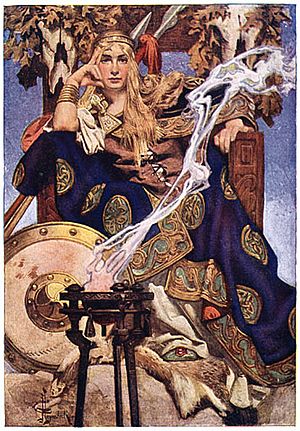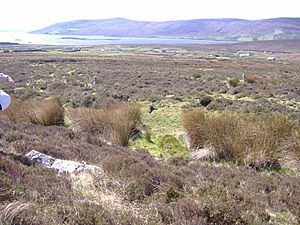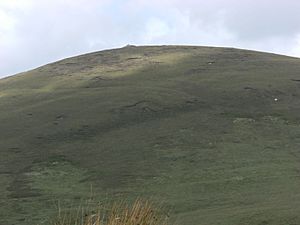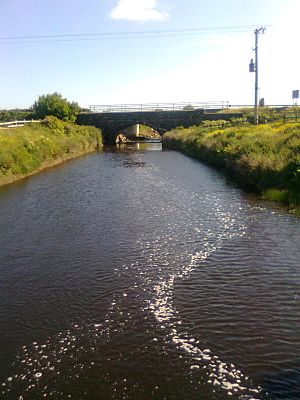Táin Bó Flidhais facts for kids
The Táin Bó Flidhais, also known as the Mayo Táin, is an exciting story from ancient Irish tales called the Ulster Cycle. It's one of many "cattle raid" stories, where heroes fight over valuable herds. The most famous one is Táin Bó Cúailnge. This story is named after its main character, Flidais.
The Táin Bó Flidhais exists in two forms. A shorter, older version and a longer one found in a 15th-century book called the Glenmasan manuscript. This longer version is thought to be a copy of an even older book from the 12th century. Interestingly, the early version of Táin Bó Flidhais is older than the famous Táin Bó Cúailnge.
Contents
- Ancient Ireland: A Land of Kings and Tribes
- The Glenmasan Manuscript: A Tragic Beginning
- The Main Story: A Cattle Raid Begins
- Bricne's Treachery
- Fierce Battles Begin
- More Treachery and a Tragic End
- The Maol Cow's Journey
- The Attack of the Wolfhounds
- The Mayo Táin: A Local Version
- See also
- Images for kids
Ancient Ireland: A Land of Kings and Tribes
These legendary stories take place a very long time ago in Ireland. This was during the Iron Age (around 50 to 500 AD) and early Medieval Ireland (around 500 to 800 AD). Back then, Ireland was split into many small areas called tuatha. Each tuath had its own king. Some kings were more powerful than others. For example, Medb was the queen of a whole province called Connacht.
Kings often fought over land borders. This story shows what happened when one king won against another. People followed special rules called Brehon Laws. Armies included both men and women who fought together.
At the same time, small churches were being built across Ireland. Some were just for one monk, often called "saints" today. Many towns are still named after these saints, like Cill Ghallagáin (Church of St. Galligan). Some small churches grew into large, rich monasteries. These monasteries were famous for creating beautiful illuminated manuscripts and crafting items with gold and silver. You can still see some of these amazing items, like the Cross of Cong or the Ardagh Chalice, in Irish museums today.
The early Christian communities and the tuatha tribes lived side by side. Sometimes they got along, and sometimes they didn't. Kings often supported local religious groups. This made the kings look more important. The people of a tuath were usually the king's extended family. This included many generations and even children from other tuatha who were raised by the king's family. This large family group formed the army that fought in battles between kings.
The Táin Bó Flidhais is not as well-known as the Táin Bó Cuailnge. However, its story is just as exciting and detailed. It features many important characters from Irish legends. These characters appear in many different story cycles from that time. Queen Maedbh, the Queen of Connacht, is one such character. Others include Cú Chulainn and the brave hero, Fergus mac Róich.
The story of the Táin Bó Flidhais takes place in the province of Connacht in Ireland. This was during the late Iron Age. The royal fort of Cruachan, near Tulsk in Roscommon, was the home of Queen Maedbh and her husband, King Ailill MacMáta.
The Glenmasan Manuscript: A Tragic Beginning
The Glenmasan manuscript adds an important part to the Táin Bó Flidhais. It tells the sad story of how the sons of Uisnech died. King Conchobar mac Nessa sent Fergus mac Róich to bring the sons of Uisnech back from Scotland. They were living in exile there. Conchobar wanted them to help him protect Ulster.
Dierdre, the wife of Naisi (one of Uisnech's sons), had a bad dream. She dreamed that Naisi would be betrayed. Fergus promised he would keep them safe. Naisi trusted Fergus, and so the sons of Uisnech returned to Ireland.
They arrived at Borrach's fortress. There, Fergus was immediately put under a Geas. A Geas was a special rule or promise that a hero had to follow. Borrach told Fergus, "I have a feast for you, Fergus. It is against your Geas to leave a feast until it's finished." Fergus was upset. He had promised Conchobar to bring the sons of Uisnech to Emain that very day. But Borrach forced him to stay.
Fergus had to remain with Borrach. So, he sent his two sons to Emain Macha with Naisi and Dierdre. Dierdre had another dream. She saw all her friends without their heads. She warned them to go to Dundalk, where Cú Chulainn was, or to Emain under Cú Chulainn's protection. She feared "treachery and ruin." But her warning was ignored again.
Naisi received a warning from his childhood friend, Levarcham. She told him it was dangerous to have Dierdre with them. Dierdre was the one Conchobar wanted most. Levarcham had been sent to check if Dierdre was still beautiful. She sadly said that "treachery and guile" would happen that night in Emain.
When Conchobar heard that Dierdre was still beautiful, he fought the sons of Uisnech to get her back. Fergus's sons fought against their own king. They wanted to protect their father's honor, as he had promised to keep Naisi and Dierdre safe. Sadly, Fergus's son Illann was killed. Because of this, Fergus left Ulster and joined Queen Maedbh at Cruachan. From this point, the story continues much like the older Irish version.
The Main Story: A Cattle Raid Begins
The Táin Bó Flidhais tells of a raid by Queen Maedbh's army. They attacked the Gamhanraidh tribe in County Mayo. The Gamhanraidh were as respected in Connacht as the Red Branch Knights were in Ulster.
The story's heroine is Flidhais Fholtchain, which means "Flidhais of the lovely soft hair." She was a stunning beauty, like a Celtic Artemis. Flidhais was married to Oilill Fionn. He was a king of the Gamhanraidh tribe and the son of a powerful chief named Domhnall Dualbhuidhe ("Donal of the yellow locks"). Domhnall lived at Glencastle in Erris.
Flidhais and Oilill owned two forts in County Mayo. One was at Rathmorgan, called Dún Flidhais. It was located at the southern end of Carrowmore Lake in Erris. The other was west of Lough Conn near Nephin, called Dún Átha Féan. The Gamhanraidh tribe, including Flidhais and Oilill, controlled large areas of land. This stretched west of the Shannon, from North Mayo down to County Clare.
Flidhais and Oilill had a famous white cow called the Maol. People said this cow gave huge amounts of milk every day. Enough to feed three hundred men, their women, and children in one milking! They also owned many other large herds of cattle and deer. Flidhais and Oilill had four daughters.
Fergus had come to Cruachan after his battles in Ulster. He wanted to gain the support of Queen Maedbh and her husband, King Ailill mac Máta. Fergus was a very impressive man. Queen Maedbh fell in love with him. Her husband, Ailill, got angry. He secretly took Fergus's special sword from its sheath and replaced it with a wooden copy.
Bricne's Treachery
Many "guests" from different tribes often stayed at Cruachan. While Fergus was there, another guest named Bricne Nimhtheanga was also present. People said he enjoyed causing trouble as much as he enjoyed telling stories. It was Bricne who started the conflict that became the Táin Bó Flidhais.
Flidhais kept her precious Maol cow at her fort, Dún Flidhais, at Rathmorgan in Erris. She often lived at this fort, while her husband stayed at the fort on Lough Conn. They had large herds of cattle at both places. This showed they were very rich, as owning cattle was the main way to measure power and wealth back then.
Bricne Nimhtheanga decided to travel to Dún Flidhais fort in Erris. His plan was to cause problems. Travelers linked to the Queen of Connacht were always treated very well. So, when Bricne arrived at Rathmorgan, Flidhais and her people welcomed him kindly. They wined and dined him in style. Flidhais had the fort filled with perfume and decorated with mistletoe and herbs.
Later, everyone went to sleep except Flidhais and Bricne. He sang to Flidhais:
From Cruachan we have come
To Erris in the west of Elga.
In every Dún we passed, we heard
Of Flidhais and her cow,
Flidhais the lady of Oilill,
Dear to me the name of the spouse,
Domhnall Dualbhuidhe's warrior son,
Bounteous the lady who will not forsake me
When we came out of Eamhain
Our quarrel left no slight track
The cause of Fergus whose exploits are many
Brought us in numbers to Cruachain
Flidhais asked Bricne to describe Fergus mac Róich to her. Bricne knew Flidhais was very interested in Fergus from old stories. He praised Fergus's charms. But he also told her that Oilill, Flidhais's husband, was a great man too.
The next morning, Bricne left Dún Flidhais and returned to Cruachan. When he got back, he told Queen Maedbh that Flidhais's fort was the most amazing palace he had ever seen. Fergus heard this and became interested in Flidhais. This made Maedbh very jealous. Bricne kept stirring up trouble among everyone.
Fierce Battles Begin
Fergus and Oilill challenged each other to a fight. First, the two chiefs fought hand-to-hand. Then, their supporters joined the battle. Many men were killed. Fergus pulled out his magic sword, but it was only the wooden copy that Ailill had put there. His sword didn't give him the special powers he expected. Oilill's troops won the fight.
Fergus was captured by the Gamhanraidh. He was held in the cells at Dún Flidhais fort. His remaining troops returned to Cruachan, dirty and tired. Back at Cruachan, Queen Maedbh was furious. She didn't want to lose Fergus to Flidhais. She gathered her army, including her tribe and all their supporters.
Maedbh's army set off for Erris. This attack became known as the Táin Bó Flidhais. They came from the south, defeating every tribe that tried to stop them. They left a trail of destruction. Queen Maedbh's daughter, Red Cainner, was killed by a spear when Maedbh herself dodged it. This caused Maedbh great sadness. She cried out:
Dig ye the grave of Cainner lying here on the mound, slain
Fermenn, son of Dara Dearg, threw the spear, which caused her death.
Red Cainner, daughter of Ailill and Maedbh.
She is the victim at the mound of the shade.
The darling of the warriors of Enian.
The spouse of Lughaid Mac Conroc.
During seven short days of delight and valour.
Raise her pillar above her grave stone.
Dig ye her grave
After the burial, the army continued. They finally reached Carrowmore Lake and the fort at Rathmorgan. Oilill and Flidhais were waiting at the fort for Queen Maedbh's army. Fergus MacRoigh was a prisoner. He was tied up and put on display for the angry Queen Maedbh to see. Oilill found himself surrounded by Maedbh's troops. He called on all his Gamhanraidh tribes to fight the approaching army.
More Treachery and a Tragic End
Queen Maedbh looked magnificent in her royal clothes. She offered the leaders of Oilill's army a deal. If they fought on her side, she would make them kings of the Gamhanraidh. She also offered them a permanent home at her royal fort in Cruachan. Every one of them accepted her offer. They left Oilill's army.
Single battles then took place between Queen Maedbh's troops and the Gamhanraidh. Even though they had fewer fighters, the Erris warriors won most of the fights. Maedbh was very upset again when three of her closest fosterlings (children she had raised) were killed.
Oilill and everyone in his household, except Flidhais, went up to the fort's walls at Rathmorgan. They wanted to see what was happening below. This left Fergus and the other prisoners alone with Flidhais inside the fort. During this time, Fergus and Flidhais made a secret plan to be together. When Oilill returned, Flidhais gave him a strong drink. She kept giving him more until he was unconscious. Then, Flidhais sent a message to Maedbh's troops to attack the fort. Oilill couldn't defend the fort, and the prisoners inside were set free.
Once Fergus was free, he wanted revenge on Oilill for how he had been treated. A fierce battle followed. Eventually, Oilill and his remaining troops retreated behind the walls of Rathmorgan fort. His Gamhanraidh army now had only 97 people left.
As morning arrived, the troops gathered again. The Gamhanraidh decided to escape to Trá Chinn Chiortain. This place was near Inver on the east shore of Broadhaven Bay. The chief of the peninsula, Ciortán, from Dún Chiortáin in Glengad, promised Oilill he would have his fastest ship ready. It would take them safely out to sea, away from the Cruachan invaders.
When Queen Maedbh's troops found the fort at Dún Flidhais empty, they chased Oilill. They followed him along the shores of Carrowmore Lake into Inver, where Ciortán's boat was waiting. However, when Ciortán saw them coming, he pulled his boat out of the harbor. He left Oilill stranded on the shore. Oilill had forgotten that Ciortán still held a grudge against him. Oilill begged Ciortán to help him, but Ciortán refused. He took his boat further into Broadhaven Bay. Furious, Oilill put a large rock into his slingshot. He fired it at Ciortán's boat. The shot hit Ciortán in the neck and killed him. Ciortán and his crew sank to the bottom of Broadhaven Bay. The bay between Barnatra and Inver is still known as Trá Chiortáin today. The Queen's army caught Oilill at Log na Fola.
Oilill died bravely. His head was cut off and brought back to Rathmorgan fort. This was to show Flidhais that she was now free. Fergus presented it to Flidhais as a gift. However, Flidhais burst into tears. She demanded that Oilill's body be brought back to their fort. The troops brought Oilill's body. When Flidhais saw him, she was filled with sadness. She began to remember all his good deeds during his life. People say that Oilill is buried just north of Inver in a mound, which is still marked on maps today.
Maedbh's army then destroyed the Rathmorgan fort. This was revenge for the deaths of several of Maedbh's children. After the fort was in ruins, the army headed east back to Cruachan. Domhnall, in his fort at Glencastle, was heartbroken to hear of his son's death. Fergus took Flidhais and her Maol cow. He also took anything else valuable from Dún Flidhais fort, along with her large herds of cattle and deer.
The Maol Cow's Journey
Fergus tried to make the Maol cow stand up and walk, but she refused. His men believed the Maol was sad because her master had died. Fergus then lost his temper. He poked the Maol with his sword. When she still wouldn't get up, he hit her nine times on her back. She bellowed and mooed so loudly that her cries could be heard for many miles. Still, the cow did not stand.
Then Bricne arrived. He said he could make the Maol get up if he received enough gifts and payment. Fergus agreed. The Maol then stood up. She led the captured herds away from Erris on the long journey towards Cruachan.
The Attack of the Wolfhounds
Queen Maedbh's army had set off towards Barrooskey. But to their surprise, they met resistance. Small groups of Gamhanraidh tribes appeared from everywhere. They attacked the retreating troops trying to return to Cruachan. There were so many attacks that the fighting turned into a full-scale battle again in the Glenamoy hills. The brave Gamhanraidh made a gruesome pile of Irish warrior heads on the ground.
At this point, Domhnall from Glencastle arrived with a new army. This army included fierce wolfhounds. Their handlers released the dogs. They attacked Maedbh's army, tearing soldiers apart. Then Fergus fought Domhnall Duabhuidhe face-to-face. Domhnall died at Glenamoy by Fergus's sword. More troops to support the Gamhanraidh arrived from Croagh Patrick.
After his grandfather's death, Muireadhach, known as Muireadhach the Stutterer, became the leader of the Gamhanraidh. He continued the attack on Maedbh's troops until he got Flidhais and her Maol cow back. Some stories say that Muireadhach later married Flidhais. Others say she lived the rest of her life quietly.
Even though they faced dangers all along their journey, the tired Maedbh, along with Ailill and Fergus, finally made it back to Cruachan. That was the end of the tale of the Táin Bó Flidhais.
The Mayo Táin: A Local Version
The story of Táin Bó Flidhais is also called 'The Mayo Táin'. There are several local versions of the story with small differences.
In local versions, Flidhais is known as Munhin. Domhnall Dualbhuidhe from Dún Domhnall fort in Glencastle takes the place of Oilill Fionn. He is Munhin's lover, not her lover's father. In one common version, the fort of Dún Domhnall in Glencastle is taken by a surprise attack. The forts of Dún Chiortain and Dún Chaochain also fall to the raiders.
Munhin watched the battles from a distance. She was very impressed by the leader of the invading army, who was Fergus. She asked for a truce. Domhnall invited his enemy, Fergus, to enjoy the hospitality of his fort, Dún Domhnall at Glencastle. It was said that Fergus was so handsome that no woman could look at him without wanting him. Compared to her husband, whose body was covered in battle scars, the young Fergus seemed like a god. Munhin found Fergus an exciting partner. She was like nine women to him.
Domhnall had a magic sword that gave him his strength. He carried it everywhere. A sorceress knew the secret to the sword. Munhin's love for Fergus grew each day. One night, they asked the sorceress for help using a magic spell. The sorceress saw their strong love. She told them the secret to taking the sword from Domhnall. At this, a thunderclap shook the glen. Munhin was scared by what she had done.
A few days later, Fergus said he was leaving Dún at Glencastle. He and Domhnall drank a lot of alcohol. Domhnall fell asleep. Munhin used the secret magic from the sorceress to cut off his sword. Fergus took the sword. With one swift move, he cut off Domhnall's head. The next morning, Fergus's flag flew over Dún Domhnall's fort. Fergus and Munhin then lived together as husband and wife.
One day, Fergus was called back to the fort at Cruachan in the middle of Ireland. Munhin insisted on going with him. They set off on a black horse in heavy rain. They reached a small river that joins the Owenmore River from Carrowmore Lake. The river was flooded. They had to cross it on one small stick. As they crossed, Fergus feared that Munhin would be unfaithful to him, just as she had been to her former husband. He pushed her, and she fell into the flooded waters. She struggled but could not save herself and drowned. The river has been known as the Munhin River ever since. After this terrible act, Fergus continued on his way. He reached Barrooskey, a remote area near Glenamoy in Erris.
See also
Images for kids











